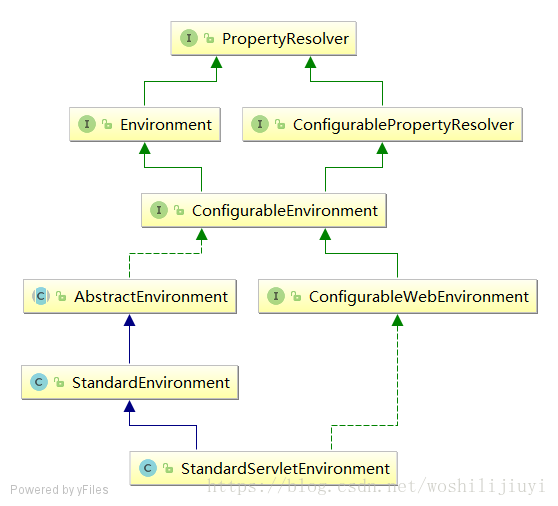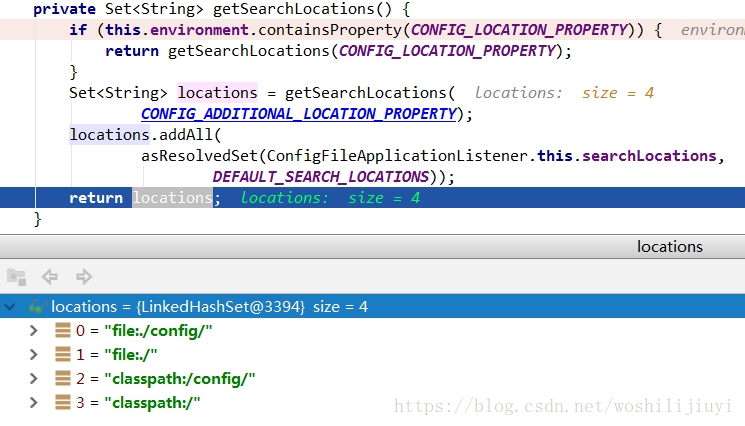SpringBoot2 | SpringBoot Environment源码分析(四)
微信公众号:吉姆餐厅ak
学习更多源码知识,欢迎关注。
SpringBoot2 | SpringBoot启动流程源码分析(一)
SpringBoot2 | SpringBoot启动流程源码分析(二)
SpringBoot2 | @SpringBootApplication注解 自动化配置流程源码分析(三)
SpringBoot2 | SpringBoot Environment源码分析(四)
SpringBoot2 | SpringBoot自定义AutoConfiguration | SpringBoot自定义starter(五)
SpringBoot2 | SpringBoot监听器源码分析 | 自定义ApplicationListener(六)
SpringBoot2 | 条件注解@ConditionalOnBean原理源码深度解析(七)
SpringBoot2 | Spring AOP 原理源码深度剖析(八)
SpringBoot2 | SpingBoot FilterRegistrationBean 注册组件 | FilterChain 责任链源码分析(九)
SpringBoot2 | BeanDefinition 注册核心类 ImportBeanDefinitionRegistrar (十)
SpringBoot2 | Spring 核心扩展接口 | 核心扩展方法总结(十一)
本篇文章主要介绍
springBoot2.x配置文件解析流程,另外会涉及SpringBoot2.x在environment处理逻辑上相对于SpringBoot1.x的变动。
springCloud的配置文件解析,则是在此基础上做了扩展。在springBoot解析逻辑之前,添加了bootstrap配置,通过监听器BootstrapApplicationListener实现。后续有详细介绍。
一、概述
Environment是 spring 为运行环境提供的高度抽象接口,项目运行中的所有相关配置都基于此接口。
springBoot对此接口做了扩展。
先来看一个简单的SpringBoot应用。
@org.springframework.boot.autoconfigure.SpringBootApplication
@RestController
public class SpringBootApplication {
@Autowired
Environment environment;
@RequestMapping(value = "/environment", method = RequestMethod.GET)
public String environment() {
//输出environment 类型
System.out.println(environment.getClass());
return JSON.toJSONString(environment);
}
}
上述代码注入的environment具体对象是什么呢?
跟着源码,搜寻答案。
二、源码分析
前面springBoot启动流程中,我们提到了有个prepareEnvironment方法:
ConfigurableEnvironment environment = prepareEnvironment(listeners,
applicationArguments);
private ConfigurableEnvironment prepareEnvironment(
SpringApplicationRunListeners listeners,
ApplicationArguments applicationArguments) {
// Create and configure the environment
//1、初始化environment
ConfigurableEnvironment environment = getOrCreateEnvironment();
//2、加载默认配置
configureEnvironment(environment, applicationArguments.getSourceArgs());
//3、通知环境监听器,加载项目中的配置文件
listeners.environmentPrepared(environment);
bindToSpringApplication(environment);
if (this.webApplicationType == WebApplicationType.NONE) {
environment = new EnvironmentConverter(getClassLoader())
.convertToStandardEnvironmentIfNecessary(environment);
}
ConfigurationPropertySources.attach(environment);
return environment;
}
接下来对上面三步进行详细分析:
1、初始化environment:
private ConfigurableEnvironment getOrCreateEnvironment() {
if (this.environment != null) {
return this.environment;
}
//springboot应用返回的environment
if (this.webApplicationType == WebApplicationType.SERVLET) {
return new StandardServletEnvironment();
}
return new StandardEnvironment();
}
可以看到根据类型进行匹配 environment,获取到StandardServletEnvironment,该实例直接注入到spring容器,所以上面示例代码的输出的类型就是StandardServletEnvironment。
StandardServletEnvironment是整个springboot应用运行环境的实现类,后面所有关于配置和环境的操作都基于此类。看一下该类的结构:

首先,StandardServletEnvironment的初始化必定会导致父类方法的初始化:AbstractEnvironment:
public AbstractEnvironment() {
//从名字可以看出加载我们的自定义配置文件
customizePropertySources(this.propertySources);
if (logger.isDebugEnabled()) {
logger.debug("Initialized " + getClass().getSimpleName() + " with PropertySources " + this.propertySources);
}
}
在构造方法中调用自定义配置文件,spring的一贯做法,模板模式,调用的是实例对象的自定义逻辑:
@Override
protected void customizePropertySources(MutablePropertySources propertySources) {
propertySources.addLast(new StubPropertySource(SERVLET_CONFIG_PROPERTY_SOURCE_NAME));
propertySources.addLast(new StubPropertySource(SERVLET_CONTEXT_PROPERTY_SOURCE_NAME));
if (JndiLocatorDelegate.isDefaultJndiEnvironmentAvailable()) {
propertySources.addLast(new JndiPropertySource(JNDI_PROPERTY_SOURCE_NAME));
}
super.customizePropertySources(propertySources);
}
因为该配置类是基于web环境,所以先加载和 servlet有关的参数,addLast放在最后:
/** System environment property source name: {@value} */
public static final String SYSTEM_ENVIRONMENT_PROPERTY_SOURCE_NAME = "systemEnvironment";
/** JVM system properties property source name: {@value} */
public static final String SYSTEM_PROPERTIES_PROPERTY_SOURCE_NAME = "systemProperties";
该类又是对StandardEnvironment的扩展,这里会调用super.customizePropertySources(propertySources);:
@Override
protected void customizePropertySources(MutablePropertySources propertySources) {
propertySources.addLast(new MapPropertySource(SYSTEM_PROPERTIES_PROPERTY_SOURCE_NAME, getSystemProperties()));
propertySources.addLast(new SystemEnvironmentPropertySource(SYSTEM_ENVIRONMENT_PROPERTY_SOURCE_NAME, getSystemEnvironment()));
}
/** System environment property source name: {@value} */
public static final String SYSTEM_ENVIRONMENT_PROPERTY_SOURCE_NAME = "systemEnvironment";
/** JVM system properties property source name: {@value} */
public static final String SYSTEM_PROPERTIES_PROPERTY_SOURCE_NAME = "systemProperties";
可以看到放入顺序是永远放在最后面,也就是先加入的在前面。systemEnvironment是在systemProperties前面,这点很重要。因为前面的配置会覆盖后面的配置,也就是说系统变量中的配置比系统环境变量中的配置优先级更高。如下:

2)加载默认配置:
protected void configureEnvironment(ConfigurableEnvironment environment,
String[] args) {
//加载启动命令行配置属性
configurePropertySources(environment, args);
//设置active属性
configureProfiles(environment, args);
}
这里接收的参数是ConfigurableEnvironment,也就是StandardServletEnvironment的父类。
继续跟进configurePropertySources方法:
protected void configurePropertySources(ConfigurableEnvironment environment,
String[] args) {
//获取配置存储集合
MutablePropertySources sources = environment.getPropertySources();
//判断是否有默认配置,默认为空
if (this.defaultProperties != null && !this.defaultProperties.isEmpty()) {
sources.addLast(
new MapPropertySource("defaultProperties", this.defaultProperties));
}
//加载命令行配置
if (this.addCommandLineProperties && args.length > 0) {
String name = CommandLinePropertySource.COMMAND_LINE_PROPERTY_SOURCE_NAME;
if (sources.contains(name)) {
PropertySource source = sources.get(name);
CompositePropertySource composite = new CompositePropertySource(name);
composite.addPropertySource(new SimpleCommandLinePropertySource(
"springApplicationCommandLineArgs", args));
composite.addPropertySource(source);
sources.replace(name, composite);
}
else {
sources.addFirst(new SimpleCommandLinePropertySource(args));
}
}
}
上述代码主要做两件事:
一是判断SpringBootApplication是否指定了默认配置,
二是加载默认的命令行配置。
上面有个核心关键类出现了,MutablePropertySources,mutable中文是可变的意思,该类封装了属性资源集合:
public class MutablePropertySources implements PropertySources {
private final Log logger;
private final List> propertySourceList = new CopyOnWriteArrayList<>();
}
该类又是如何使用的呢?

这里的设计很巧妙,将MutablePropertySources传递到文件解析器propertyResolver中,同时AbstractEnvironment又实现了文件解析接口ConfigurablePropertyResolver,所以AbstractEnvironment就有了文件解析的功能。所以StandardServletEnvironment文件解析功能实际委托给了PropertySourcesPropertyResolver来实现。
继续看一下configureProfiles(environment, args);方法:
protected void configureProfiles(ConfigurableEnvironment environment, String[] args) {
environment.getActiveProfiles(); // ensure they are initialized
// But these ones should go first (last wins in a property key clash)
Set profiles = new LinkedHashSet<>(this.additionalProfiles);
profiles.addAll(Arrays.asList(environment.getActiveProfiles()));
environment.setActiveProfiles(StringUtils.toStringArray(profiles));
}
该方法主要将SpringBootApplication中指定的additionalProfiles文件加载到environment中,一般默认为空。
该变量的用法,在项目启动类中,需要显示创建SpringApplication实例,如下:
SpringApplication springApplication = new SpringApplication(MyApplication.class);
//设置profile变量
springApplication.setAdditionalProfiles("prd");
springApplication.run(MyApplication.class,args);
3、通知环境监听器,加载项目中的配置文件
触发监听器:
listeners.environmentPrepared(environment);
在SpringBoot2 | SpringBoot启动流程源码分析(一)中提到了该方法通知的监听器,和配置文件有关的监听器类型为ConfigFileApplicationListener,监听到事件时执行的方法:
@Override
public void postProcessEnvironment(ConfigurableEnvironment environment,
SpringApplication application) {
//加载项目中的配置文件
addPropertySources(environment, application.getResourceLoader());
configureIgnoreBeanInfo(environment);
bindToSpringApplication(environment, application);
}
继续跟进去,会发现一个核心内部类 Loader ,配置文件加载也就委托给该内部类来处理:
private class Loader {
private final Log logger = ConfigFileApplicationListener.this.logger;
//当前环境
private final ConfigurableEnvironment environment;
//类加载器,可以在项目启动时通过 SpringApplication 构造方法指定,默认采用 Launcher.AppClassLoader加载器
private final ResourceLoader resourceLoader;
//资源加载工具类
private final List propertySourceLoaders;
//LIFO队列
private Queue profiles;
//已处理过的文件
private List processedProfiles;
private boolean activatedProfiles;
Loader(ConfigurableEnvironment environment, ResourceLoader resourceLoader) {
this.environment = environment;
//获取类加载器
this.resourceLoader = resourceLoader == null ? new DefaultResourceLoader()
: resourceLoader;
//获取propertySourceLoaders
this.propertySourceLoaders = SpringFactoriesLoader.loadFactories(
PropertySourceLoader.class, getClass().getClassLoader());
}
//......
}
上面propertySourceLoaders通过 SpringFactoriesLoader 获取当前项目中类型为 PropertySourceLoader 的所有实现类,默认有两个实现类,如下图:

继续来看主要解析方法:load():
public void load() {
this.profiles = Collections.asLifoQueue(new LinkedList());
this.processedProfiles = new LinkedList<>();
this.activatedProfiles = false;
this.loaded = new LinkedHashMap<>();
//初始化逻辑
initializeProfiles();
//定位解析资源文件
while (!this.profiles.isEmpty()) {
Profile profile = this.profiles.poll();
load(profile, this::getPositiveProfileFilter,
addToLoaded(MutablePropertySources::addLast, false));
this.processedProfiles.add(profile);
}
//对加载过的配置文件进行排序
load(null, this::getNegativeProfileFilter,
addToLoaded(MutablePropertySources::addFirst, true));
addLoadedPropertySources();
}
跟进去上面初始化方法:
private void initializeProfiles() {
Set initialActiveProfiles = initializeActiveProfiles();
this.profiles.addAll(getUnprocessedActiveProfiles(initialActiveProfiles));
//如果为空,添加默认的profile
if (this.profiles.isEmpty()) {
for (String defaultProfileName : this.environment.getDefaultProfiles()) {
Profile defaultProfile = new Profile(defaultProfileName, true);
if (!this.profiles.contains(defaultProfile)) {
this.profiles.add(defaultProfile);
}
}
}
// The default profile for these purposes is represented as null. We add it
// last so that it is first out of the queue (active profiles will then
// override any settings in the defaults when the list is reversed later).
//这里添加一个为null的profile,主要是加载默认的配置文件
this.profiles.add(null);
}
上面主要做了两件事情:
1)判断是否指定了profile,如果没有,添加默认环境:default。后面的解析流程会解析default文件,比如:application-default.yml、application-default.properties。
注意:在第2步中我们提到了
additionalProfiles属性,如果我们通过该属性指定了profile,这里就不会加载默认的配置文件,根据我们指定的profile进行匹配。
2)添加一个null的profile,主要用来加载没有指定profile的配置文件,比如:application.properties
因为 profiles 采用了 LIFO 队列,后进先出。所以会先加载profile为null的配置文件,也就是匹配application.properties、application.yml。
继续跟进解析方法load:
private void load(Profile profile, DocumentFilterFactory filterFactory,
DocumentConsumer consumer) {
//获取默认的配置文件路径
getSearchLocations().forEach((location) -> {
boolean isFolder = location.endsWith("/");
Set names = (isFolder ? getSearchNames() : NO_SEARCH_NAMES);
//循环加载
names.forEach(
(name) -> load(location, name, profile, filterFactory, consumer));
});
}
可以看到springBoot2.0底层的新的改动都是基于
lambda表达式实现。
获取路径之后,会拼接配置文件名称,选择合适的yml或者properties解析器进行解析:
(name) -> load(location, name, profile, filterFactory, consumer)
具体的解析逻辑比较简单,我们来梳理一下:
1)获取默认的配置文件路径,有4种。
2)遍历所有的路径,拼装配置文件名称。
3)再遍历解析器,选择yml或者properties解析,将解析结果添加到集合MutablePropertySources当中。
至此,springBoot中的资源文件加载完毕,解析顺序从上到下,所以前面的配置文件会覆盖后面的配置文件。可以看到application.properties的优先级最低,系统变量和环境变量的优先级相对较高。
SpringBoot2.x和SpringBoot1.x不同点
主要有两处大的变化:
一、在SpringBoot1.x版本中,如果我们定义了application-default.properties文件,优先级顺序:

application-default.properties > application-dev.properties > application.properties
在SpringBoot2.x版本中,如果我们定义了application-default.properties文件,会有两种情况:
1)没有配置application-dev.properties文件,优先级顺序:
application-default.properties > application.properties
2)同时配置了application-dev.properties文件,优先级顺序:
application-dev.properties > application.properties
这是因为在2.x版本中,如果定义了application-dev.properties文件,application-default.properties文件将会删除。
代码中,在解析application.properties时会有如下判断,判断是否有 active 文件,如果有,则会删除默认的profile:
private void maybeActivateProfiles(Set profiles) {
if (profiles.isEmpty()) {
return;
}
if (this.activatedProfiles) {
this.logger.debug("Profiles already activated, '" + profiles
+ "' will not be applied");
return;
}
addProfiles(profiles);
this.logger.debug("Activated profiles "
+ StringUtils.collectionToCommaDelimitedString(profiles));
this.activatedProfiles = true;
//删除默认的配置文件,即application-default.* 文件
removeUnprocessedDefaultProfiles();
}
private void removeUnprocessedDefaultProfiles() {
this.profiles.removeIf(Profile::isDefaultProfile);
}
二、SpringBoot 1.x版本中,项目的配置文件统一被封装在内部类ConfigFileApplicationListener$ConfigurationPropertySources对象中,存入environment。而在2.x版本中,配置文件则是分别被包装成OriginTrackedMapPropertySource存入environment中
在springboot1.x升级到springboot2.x的时候,还请注意以上两点。
SpringBoot2 | SpringBoot启动流程源码分析(一)
SpringBoot2 | SpringBoot启动流程源码分析(二)
SpringBoot2 | @SpringBootApplication注解 自动化配置流程源码分析(三)
SpringBoot2 | SpringBoot Environment源码分析(四)
SpringBoot2 | SpringBoot自定义AutoConfiguration | SpringBoot自定义starter(五)
SpringBoot2 | SpringBoot监听器源码分析 | 自定义ApplicationListener(六)
SpringBoot2 | 条件注解@ConditionalOnBean原理源码深度解析(七)

